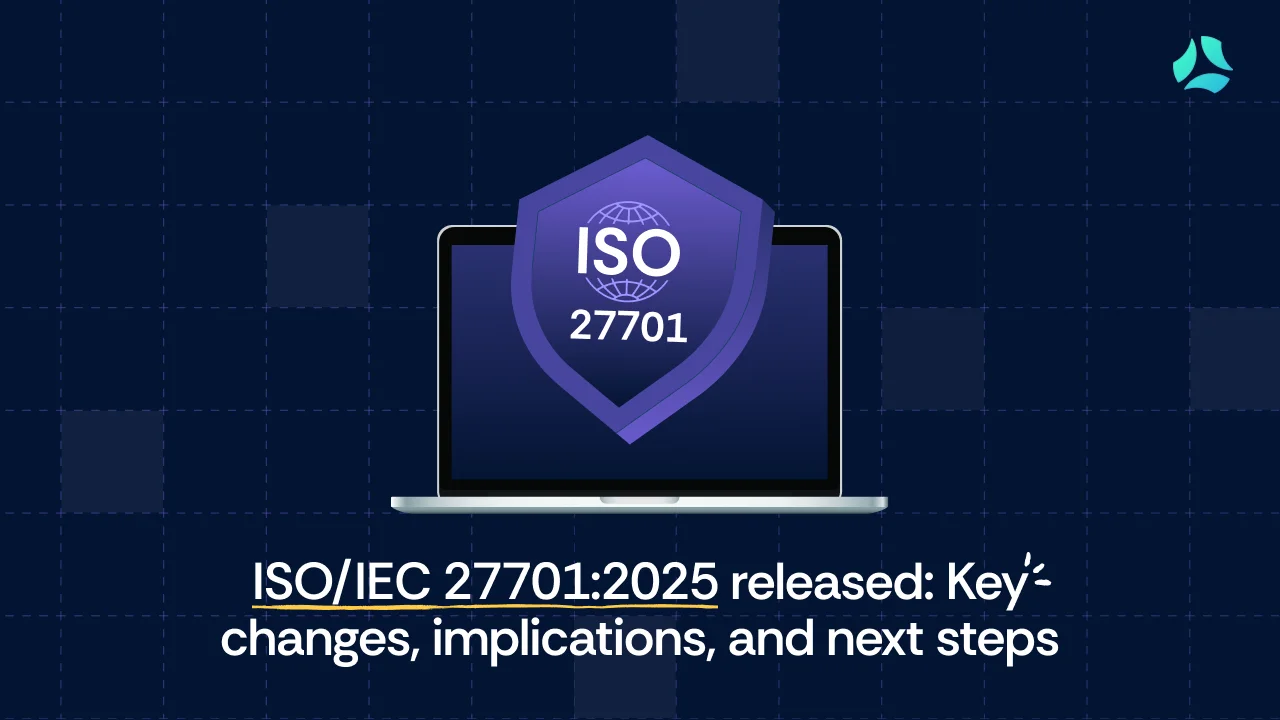Top 5 cybersecurity frameworks for reducing cyber risk

The recent DeepSeek data breach, which exposed over a million sensitive records, is yet another reminder of the growing cyber threat landscape. As attackers develop increasingly sophisticated methods, organizations must stay ahead with strong security measures.
Cybersecurity frameworks play a critical role in protecting sensitive data and maintaining regulatory compliance. They provide a structured approach to risk management, helping businesses safeguard their digital assets.
This cybersecurity framework list outlines effective ways to minimize risks and secure digital assets. Below, we explore the top cybersecurity frameworks, their importance, benefits, and how to choose the right cybersecurity strategy for your organization.
What are cybersecurity frameworks?
Cybersecurity frameworks are structured guidelines that help organizations manage and reduce cyber risks. They outline best practices for identifying threats, securing systems, and responding to incidents, ensuring you stay ahead of potential security breaches.
They typically cover:
- Risk management – identifying and prioritizing your most critical risks
- Access control – defining who can access what systems and data
- Incident response – outlining steps to take when a breach occurs
- Compliance – ensuring alignment with legal and industry-specific regulations
- Security policies and procedures – setting clear rules and expectations for employees and systems
Instead of reacting to threats as they arise, these frameworks help organizations put preventive measures in place to stay resilient.
Why are cybersecurity frameworks important?
Cybersecurity frameworks provide structured guidelines for identifying vulnerabilities, securing systems, and responding to incidents—helping organizations stay ahead of evolving threats.
While not always legally binding, many frameworks often align with regulatory expectations and industry best practices. This makes it easier for organizations to demonstrate compliance and avoid legal, financial, or reputational risks.
They also support a proactive approach to security, helping teams eliminate guesswork, protect sensitive data, ensure business continuity, and build trust with customers and partners. Organizations that adopt a framework are better equipped to prevent breaches, reduce risk, and respond effectively to new challenges.
How to choose the right cybersecurity framework?
Choosing the right cybersecurity framework can help strengthen security, ensure compliance, and manage risk effectively.
Here are the key factors to consider:
- Industry requirements – Some sectors mandate specific frameworks. For instance, NIST SP 800-171 is required under the Defense Federal Acquisition Regulation Supplement (DFARS) for contractors and subcontractors handling Controlled Unclassified Information (CUI).
- Regulatory compliance – Aligning your framework with legal requirements such as GDPR or HIPAA helps avoid penalties, improves audit readiness, and ensures customer trust.
- Risk profile and business objectives – Organizations with high cyber risk may prioritize NIST CSF, while broader governance concerns might align with COBIT.
- Scalability and flexibility – The framework should evolve with business growth and adapt to emerging threats. For instance, NIST CSF allows customization to fit different risk levels.
- Integration with existing security measures – The chosen framework should align with your organization’s existing systems, policies, and governance structures to ensure a smooth and effective implementation.
- Implementation complexity – Consider the effort required for adoption, training, and maintenance. Some frameworks require significant resources, while others offer a more streamlined approach.
- Continuous monitoring and improvement – Frameworks with built-in assessment and audit mechanisms, like NIST CSF, ensure ongoing security improvements.

Top 5 cybersecurity frameworks
Cybersecurity frameworks provide a structured approach to managing security risks, protecting sensitive data, and meeting compliance obligations. While some are industry-agnostic, others are designed for specific sectors or regulatory environments. Below are five key cybersecurity frameworks, their purpose, applicability, and benefits.
1. NIST Cybersecurity Framework (NIST CSF)
Developed by the National Institute of Standards and Technology (NIST), part of the U.S. Department of Commerce, the NIST CSF provides a voluntary, risk-based approach to managing cybersecurity threats.
It assists organizations in identifying, protecting, detecting, responding to, and recovering from cyber incidents, with Version 2.0 (released February 2024) adding a “Govern” function to enhance oversight.
Though not mandatory, it is widely adopted as a best practice, particularly in critical infrastructure sectors like energy, finance, and healthcare, and is adaptable for businesses of all sizes seeking a structured cybersecurity risk management approach.
Key benefits:
- Offers a flexible, scalable framework customizable to diverse needs.
- Aligns with international standards such as ISO/IEC 27001.
- Enables organizations to assess and enhance their cybersecurity maturity.
- Supports alignment with regulations like GDPR, HIPAA, and CCPA.
2. Operationally Critical Threat, Asset, and Vulnerability Evaluation (OCTAVE)
Developed by Carnegie Mellon University’s Software Engineering Institute (SEI), OCTAVE is a risk-based cybersecurity framework designed to help organizations identify, prioritize, and manage cybersecurity risks through a self-directed, operational focus. Introduced in the late 1990s and refined over time (e.g., OCTAVE Allegro in 2007), it emphasizes understanding critical assets, threats, and vulnerabilities from an organizational perspective rather than relying on external mandates.
It guides organizations through a structured process of asset identification, risk assessment, and mitigation planning, making it particularly useful for entities seeking a tailored, hands-on approach to cybersecurity risk management. OCTAVE is widely applicable across industries, including government, education, and private sectors, and is especially valuable for organizations with limited resources or those building internal risk management capabilities.
Key benefits:
- Provides a flexible, self-assessment methodology adaptable to any organization size or type.
- Focuses on operational risks tied to critical assets, enhancing practical decision-making.
- Encourages organizational ownership of cybersecurity without requiring extensive external expertise.
- Complements broader frameworks like NIST CSF by offering a lightweight, risk-centric process.
3. HITRUST Common Security Framework (HITRUST CSF)
Developed by HITRUST, a collaboration of healthcare, technology, and security leaders, the HITRUST CSF is a cybersecurity framework designed to manage risk and ensure compliance across industries. Launched in 2007 and updated regularly (e.g., Version 11.3.0 in April 2024), it provides a risk-based methodology that harmonizes over 60 security and privacy standards, including NIST, ISO 27001, and HIPAA, into a single, scalable approach. Originally focused on healthcare, it has evolved for broader use, helping organizations assess, mitigate, and govern cybersecurity risks while aligning with diverse regulatory requirements.
Key benefits:
- Offers a comprehensive, flexible framework adaptable to various industries and risk levels.
- Streamlines compliance by integrating multiple standards into one cohesive methodology.
- Provides a certifiable process, enhancing trust and credibility with stakeholders.
- Supports risk management and regulatory alignment, including GDPR, HIPAA, and NIST frameworks.
4. ISO/IEC 27001 (Information Security Management System)
Developed by the International Organization for Standardization (ISO) and the International Electrotechnical Commission (IEC), ISO/IEC 27001 is a framework for establishing, implementing, maintaining, and continually improving an Information Security Management System (ISMS). First published in 2005 and updated (e.g., 2022 revision), it provides a structured, risk-based approach to managing information security risks, including cybersecurity threats.
It guides organizations through identifying assets, assessing risks, and applying controls to protect sensitive data, making it widely adopted across industries like finance, healthcare, and technology. While certifiable as a standard, it offers a flexible methodology for organizations of all sizes to align security practices with business objectives and regulatory requirements.
Key benefits:
- Provides a systematic, customizable framework for managing security risks.
- Enhances organizational resilience through a comprehensive ISMS.
- Supports compliance with regulations like GDPR, HIPAA, and CCPA.
- Aligns with other frameworks like NIST CSF and HITRUST CSF for integrated security.
5. Cybersecurity Capability Maturity Model (C2M2)
Developed by the U.S. Department of Energy (DOE) in collaboration with industry and government partners, the Cybersecurity Capability Maturity Model (C2M2) is a framework designed to assess and improve an organization’s cybersecurity capabilities. Introduced in 2012 and updated (e.g., Version 2.1 in 2022), it uses a maturity model approach to help organizations evaluate their security posture across ten domains, such as risk management, incident response, and asset protection.
It assists organizations in identifying gaps, prioritizing improvements, and building resilience against cyber threats, with a focus on critical infrastructure sectors like energy, utilities, and manufacturing, though adaptable to any industry. C2M2’s voluntary, self-assessment methodology makes it practical for organizations seeking to measure and enhance cybersecurity maturity.
Key benefits:
- Offers a flexible, maturity-based framework to benchmark and improve cybersecurity.
- Supports risk management and capability development tailored to organizational needs.
- Aligns with frameworks like NIST CSF for a cohesive security strategy.
- Enables continuous improvement through clear maturity levels and actionable steps.
How to implement a cybersecurity framework
Implementing a cybersecurity framework is straightforward when you follow these essential steps:
- Assess your security posture – Identify vulnerabilities, threats, and gaps in your current security practices.
- Get executive buy-in – Secure support from leadership to ensure the cybersecurity program has the resources, visibility, and authority it needs to succeed.
- Select the right framework – Choose a framework that aligns with your industry, compliance requirements, and risk profile.
- Develop security policies and controls – Implement measures based on the framework’s guidelines to protect your digital assets.
- Integrate with existing security measures – Ensure the framework complements and strengthens your current security infrastructure.
- Train employees – Educate staff on security best practices to enhance awareness and compliance.
- Monitor and audit regularly – Continuously assess security controls, conduct audits, and update policies to address emerging threats.
Automate cybersecurity frameworks with Scrut
Managing cybersecurity frameworks manually can be complex and time-consuming. Scrut simplifies the process by automating compliance workflows, risk assessments, and policy management.
With continuous monitoring and real-time insights, Scrut helps organizations stay compliant, reduce cyber risks, and streamline security operations with ease.

FAQs
1. Can organizations use multiple cybersecurity frameworks at the same time?
Yes, many organizations adopt a combination of frameworks to address different security, compliance, and risk management needs
2. Are cybersecurity frameworks mandatory for all businesses?
Not all cybersecurity frameworks are legally required, but certain industries and regions mandate compliance with specific ones.
3. How often should a cybersecurity framework be updated or reviewed?
Cybersecurity frameworks should be regularly reviewed and updated to account for evolving threats, regulatory changes, and organizational growth. Annual audits, risk assessments, and continuous monitoring help ensure ongoing compliance and security effectiveness.


















